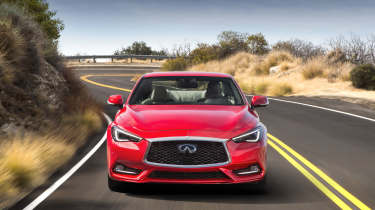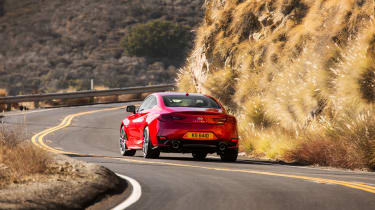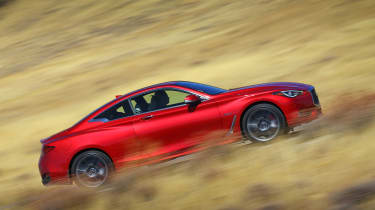Infiniti Q60S review - Can the Japanese coupe compete against its German rivals?
Infiniti has its sights set on the establishment with its high-tech and powerful Q60S
What is it?
This is Infiniti’s stab at breaking into the premium sports coupe market. The sector that is currently occupied by the Audi S5, the Mercedes-AMG C43 Coupe and the BMW 440i. To do that, Infiniti has equipped the Q60S with four-wheel drive and a 3-litre twin turbocharged V6, just like the Audi and the Mercedes.
> Click here to read our Mercedes-AMG C43 review
As well as being rather more elaborate styled than its competitors, the Infiniti has 400bhp to elevate it above its rivals. That’s 38bhp more than the Mercedes-AMG C43, 51bhp more than Audi’s recently released S5 and 78bhp more than BMW’s new 440i.
Technical highlights?
The Q60S has a plethora of technical assets. To begin with there are safety systems including radar guided cruise control that looks two cars ahead to better detect any slowing of traffic, a system that keeps you in your lane on motorways and stops you pulling into any cars that might be in your blind spot, and another detection system that alerts you if there is a car approaching as you reverse out of a parking space.
The Q60S has double-wishbone front suspension and a multilink rear axle. The chassis is controlled by adaptive dampers that change their attitude depending on which one of the driving modes you select: Snow, Eco, Standard, Sport and Sport+. A viscous coupling distributes the torque between the two axles, the Q60 is rear wheel drive most of the time but the front wheels are called into play should more traction be needed. Then there’s Active Trace Control, a brake-assisted torque vectoring system, to further keep you on your desired path.
But the most remarkable piece of technology in the Q60S is its steering. The Q60S has what Infiniti call Direct Adaptive Steering (DAS), it is a steer-by-wire system and so the Q60 has no direct connection from the steering wheel to the front wheels. There is a mechanical back-up for safety reasons, but when driving normally all the steering and feedback is performed by electronic servos. This means that the steering can adopt various different ratios depending on the speed of the car and which driving mode it is in.
Engine, transmission and 0-60 time
The Q60S's 2997cc twin turbocharged V6 may well give it more power than its rivals, but the engine doesn’t shout about it; the exhaust is quiet, with no unnecessary pops or crackles. Instead it revs with a smooth and clean noise that is pleasant, if slightly lacking any drama.
More reviews
Group tests
- Alpine A290 v Alpine A110 – how much DNA do they really share?
- Ariel Atom 4R v Caterham Seven ‘evo25’: power-to-weight heroes go head-to-head
- Caterham Super Seven 600 v Super Seven 2000
- Levante v T1
- Corvette Stingray v Porsche Cayman GTS v Audi R8 RWD
- Great Ferrari hypercars driven: 288 GTO, F40, F50 and Enzo head-to-head
- Hardcore Ferrari V8 specials go head-to-head
- Lamborghini Aventador Ultimae v Lamborghini Countach
- Lotus Emira v Morgan Plus Four – four-cylinder Brits go head-to-head
- Toyota GR86 v BBR Mazda MX-5: supercharged drop-top battles sports coupe
In-depth reviews
- Abarth 600e 2025 review – Italy gives the Alpine A290 something to worry about
- Alpine A110 review – distinctive, lightweight and unforgettable to drive
- Audi R8 (2015 - 2024) review – the ultimate soft-focus supercar
- Bentley Continental R Mulliner: review, history and specs
- BMW 5-series review – is this still Munich’s anchor model?
- BMW 1-series review – Munich’s Audi A3 rival gains focus
Long term tests
- Abarth 695C Turismo Fast Fleet test – 10,000 miles in the Italian hot hatch
- Alfa Romeo Giulia Veloce Fast Fleet test – 7000 miles in the sharp Italian saloon
- Alpina B10: end of term report
- Alpina B10
- Ford Mustang GT
- Ford Mustang GT
- Ford Mustang GT
- Land Rover Defender 110 Fast Fleet test – 9000 miles in the go-anywhere SUV
- Maserati Ghibli Trofeo Fast Fleet test – 4000 miles in the Ferrari-powered saloon
- Mitsubishi Evo MR 340
Review
- New Aston Martin DBS 770 Ultimate review – 759bhp super-GT driven
- New Bentley Batur 2023 review – can it possibly be worth £1.65m?
- 2023 Chevrolet Corvette C8 Z06 review – the American 911 GT3?
- Kia EV6 GT-Line S prototype review – the EV that shows how it’s done
- BBR Supercharged Mazda MX-5 (ND) 2023 review – tuned 250bhp roadster driven
- MG4 Trophy 2023 review
Reviews
- Abarth 695 75 Anniversario edition 2024 review – a fitting send-off for Abarth’s hot supermini?
- Abarth 500e 2023 review
- AC Cobra 378 Superblower MkIV 2021 review – another V8 Cobra, but with a GM heart this time
- Acura Integra Type S 2024 review – a Honda Civic Type R with added restraint
- Alfa Romeo Giulia 2025 review – get one while you still can
- Alfa Romeo SZ: history, review and specs of an icon
- Alfa Romeo 1750 TBi
- Alpina B3 GT Touring 2025 review – a 190mph alternative to the BMW M3 Touring
The automatic gearbox is a traditional torque converter. It isn’t the quickest transmission, whether it’s left in auto or if you use the steering wheel mounted paddles and downshifts do seem particularly laboured. Sadly the delay in changing gear robs you of a lot of enjoyment from the engine, which revs cleanly without hesitation.
The Q60S doesn’t seem to have the shove that you’d expect from 400bhp, thouhgh. It may well be 200kg heavier than the C43, but the Q60 is also very quiet with little to no wind and tyre noise. This refinement cossets you and makes it difficult to judge how quick you’re traveling, because quite often it’s faster than you expect. The Q60S certainly can shift, but it does so in a more subtle way than its 0-62mph time of 5.0sec suggests.
What’s it like to drive?
There is a huge range of movement from the seat and steering wheel so finding the ideal driving position is easy. It does initially feel like your sat too high, but actually that’s because the windscreen scuttle is low giving you a great view ahead.
With the cabin noise similar to some of the most luxurious cars on the market, the Q60S is surprisingly firm and the ride, even when in Standard mode, only really settles on the smoothest of roads. But that firm ride does translate into real agility, the Q60S changes direction instantly with very little roll. The steering doesn’t transmit much in the way of meaningful feedback to your fingertips but as the Q60S responds loyally to your inputs it doesn’t take long before it feels intuitive to place the Q60S, even with the changing steering ratio.
The torque vectoring system is very effective, contributing to the Q60S’s accuracy. However, the combination of the torque vectoring and four-wheel drive means there’s not a lot of joy or satisfaction to be had when you really push. With Sport or Sport+ mode engaged there is a palpable sense of the Infiniti sending power to the rear as it pushes you out of a corner. But this doesn’t translate into oversteer and certainly doesn’t require any correction from the driver. There is plenty of traction and the Q60S remains composed in almost any situation, it even found surprising amounts of grip on unseasonably wet Californian roads.
Disable the traction control and things are very different. Initial turn in is similarly darty, but as you power of a corner the Q60S’s front end pushes on. What’s more, the steering doesn’t communicate any of this, and you only become aware of the understeer when you find yourself carving a wider arc than you intended. The extremely slippery surface of the wet roads may have exasperated the problem, but what they did reveal is how reliant the Q60S is on its traction control, torque vectoring electronic systems.
Rivals
The Q60S is more luxurious than the German coupes that it is going head to head with. And although its rivals aren’t significantly more engaging to drive, but they don’t rely so heavily on their electronic aids. Ultimately that makes them slightly more entertaining to drive.





